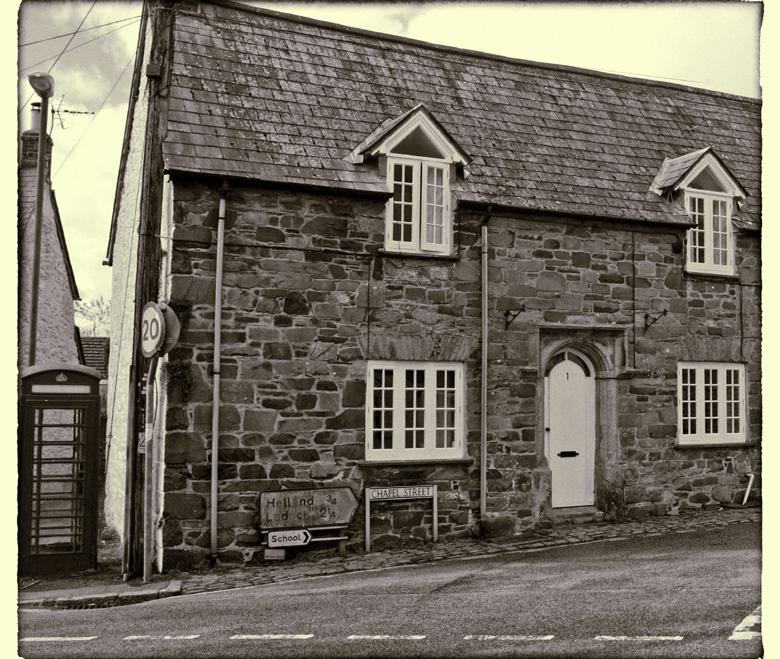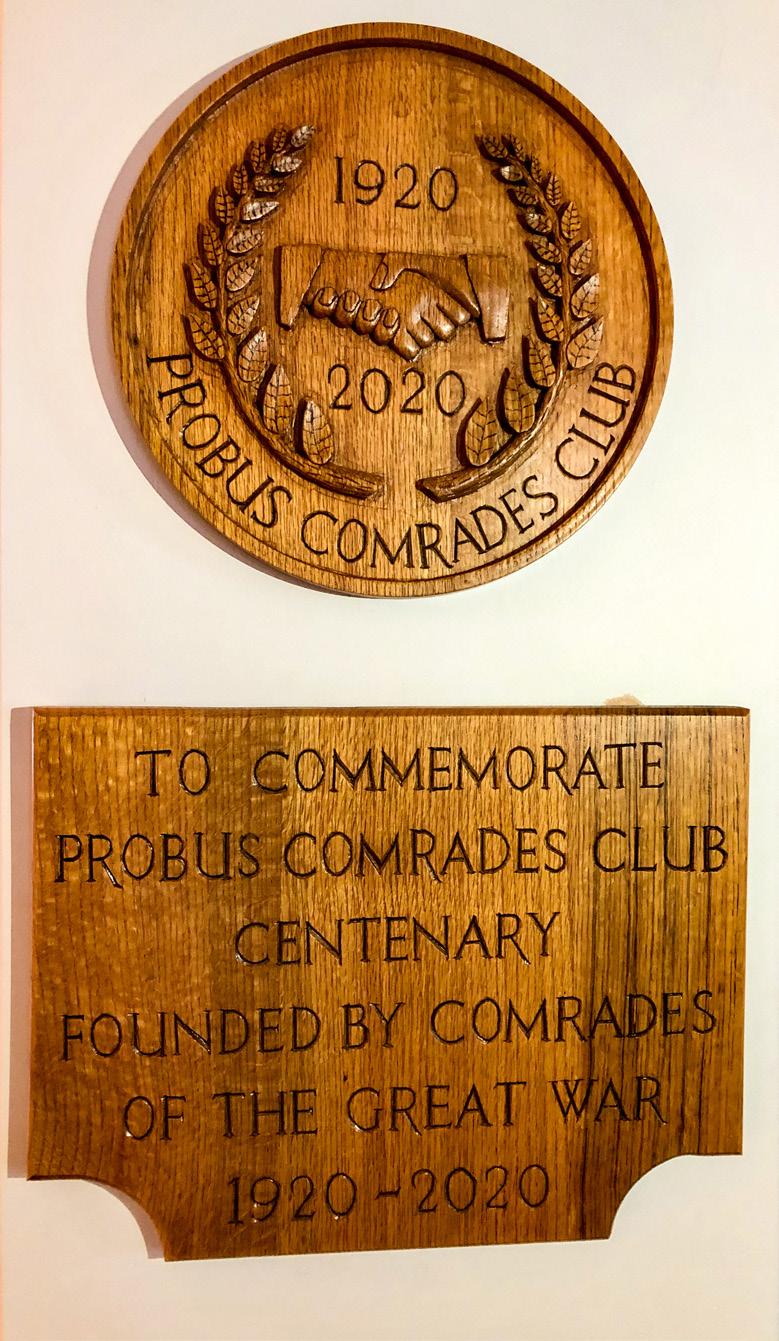
6 minute read
Comrades Club Centenary
WEDNESDAY 7th October 2020 marked 100 years to the day since the Comrades Club formally opened its doors. Thanks to the current COVID-19 restrictions, we haven’t been able to celebrate as we would have liked, but here’s a brief look back at the history of this much-loved Probus institution.
Formed by the returning comrades of the 1914–18 Great War, the principal objectives of the club have always remained, and indeed form the basis of the rules of the club - to perpetuate the feeling of comradeship generated in the First World War; to foster good fellowship and social intercourse and to provide facilities for recreation and amusement. It was intended to be a place to reflect, talk, laugh and cry, to celebrate the lives of those who returned and, more especially, those who did not.
Advertisement

The notice in the West Briton, published on 14th October 1920.
For the first two decades or so of its existence, the club rented premises at 1 Cornish Mount on the corner of The Square and Chapel Street, the site of a former pub and now a Grade II listed building and private dwelling. There may be some confusion about what that pub was actually called The Book of Probus, by Alan M. Kent and Danny L.J. Merrifield, lists it as the Cornish Mount, while Historic England’s description of the building identifies it as having once been The Bell public house. Whatever the name, it appears to have closed by the end of 1918.

1 Cornish Mount, the first home of the Comrades Club.
While the Comrades Club was initially open only to Probus ex-servicemen, at the opening ceremony the hope was expressed that ‘it would eventually be open to those men of the village who had no opportunity of serving during the Great War’. In time the club was indeed opened for all men of Probus, and by the mid-1930s the membership had grown to such an extent that larger premises were needed. In November 1940, members agreed to buy two parcels of land in Tregony Road, the site now occupied by local businesses, on which to build new premises. Just as the purchase had been agreed, however, the club was offered the chance to buy The Letter B pub on St Austell Road. A ready-equipped pub had obvious advantages over a building plot and, in February 1942, The Letter B was acquired for the princely sum of £450. This was the beginning of the club as it is today, The Letter B being the lower half of the current premises and comprising a downstairs bar and an upstairs snooker room.

Kate Reynolds behind the bar, c.1950
The Comrades Club today – this part of the building was formerly Rockery Villa, acquired by the club in 1968. In the mid-1960s Rockery Villa, the residential property next door, became available and it was acquired by the club in July 1968 for £2900. Interestingly, Rockery Villa had formerly been the home of Thomas and Kate Reynolds – Thomas being caretaker and then steward of the club from 1942 until his death in 1951 - and Kate worked behind the bar in what was, at the time, a strictly male-only bastion.
A handwritten note found in the family bible gives an insight into his duties: 1. Brush and dust the premises daily. 2. Wash downstairs floor – fortnightly. 3. Upstairs when necessary. 4. Lay and light fires when required. 5. Check the delivery of goods. 6. Entrance doors, Reading and Billiard room to be opened 9 am. 7. Sanitary of urinal. 8. See club is not used by unauthorised persons.

The groundfloor part of Rockery Villa was opened in November 1970 as a mixed-bar for both sexes. Ladies had been admitted as associate members in 1968, although they were forbidden from using the lower men-only bar. It was not until 1987 that women were admitted as full members, having voting rights and being eligible to be elected to Committee. In 2001 a junior membership was introduced for 16–17 year olds, with younger children admitted when accompanied by parents or guardians.

Tom and Kate Reynolds with granddaughter Linda Beland, outside the rear of Rockery Villa, c. 1948–49.

Arial view: The Comrades Club and Rockery Villa, July 1965 – this was taken three years before the Club acquired Rockery Villa, creating the building we know today.
Further refurbishments since then have seen the club take on its present form and there are now bars on the two floors, the upper forming a licensed function suite that can be hired for special occasions. Improvements to heating, new carpet and redecorating of the downstairs bar were completed in March this year, just prior to the closure of the club for 16 weeks as a consequence of the COVID-19 pandemic.
The club is run, as it has been since its beginning, by a committee elected by the members and is a non-profitmaking organisation, with any money raised from events and drinks sales being ploughed back into maintenance and refurbishment of the building. The steward is the only full-time salaried post, ably assisted by a number of part-time bar staff who keep the place running smoothly.
Today, the club has about 200 members, although in normal (i.e. non-COVID-19) circumstances, there are usually 300 or more members. The club plays host to a wide variety of events and village meetings. There are hugely popular monthly acoustics (open-mic) nights where local musicians can showcase their talents, featuring everything from folk and jazz to rock and even poetry recitations. The Knit & Natter group meets there every week to – well, natter and knit! Bingo nights have been running for many years and the club also has darts and pool teams who take part in local leagues. And, of course, the club is the only venue in the village that shows live sport on big-screen TVs, which is a major draw for sports fans. A real ale festival is held annually – usually on the last May Bank Holiday weekend - with generous sponsorship from local businesses. More recently there’s been the World’s Hog’s Pudding Championships with butchers from near and far entering puddings for tasting.



President David Juleff and former steward and long-serving member Bill Pollard, unveiling the centenary commemorative plaque on 7th October.

Commemoration plaques, donated by Dennis Keam and hand carved by Roger Gluyas

Some of the current committee who were able to attend the commemoration on 7th October
All this requires a lot of organisation and, over the years, so many people have given their time and energy to this community hub that it’s impossible to list and thank them all. It was hoped that the club’s centenary would be celebrated with a variety of events and functions for all the village to enjoy but, for obvious reasons, this has not been possible. Nonetheless, on Wednesday 7th October there was a somewhat muted but poignant commemoration: two plaques, donated by Dennis Keam and hand carved by Roger Gluyas, were unveiled by chairman David Juleff and former steward and long-serving member Bill Pollard. The plaques now takes pride of place in the downstairs bar. Nearby there is a photograph of three local young men dressed as soldiers of the Great War taken during the moving commemoration staged in November 2018 – perhaps, a poignant reminder of the club’s origins and purpose.

Abigail Hobbs
Article credits: Adapted from The Book of Probus, by Alan M. Kent and Danny L.J. Merrifield (Halsgrove, 2004), with additional material by Sarah Hoggett, David Juleff, Richard Puttick and others. November 2018 Beacon image by Abigail Hobbs.





